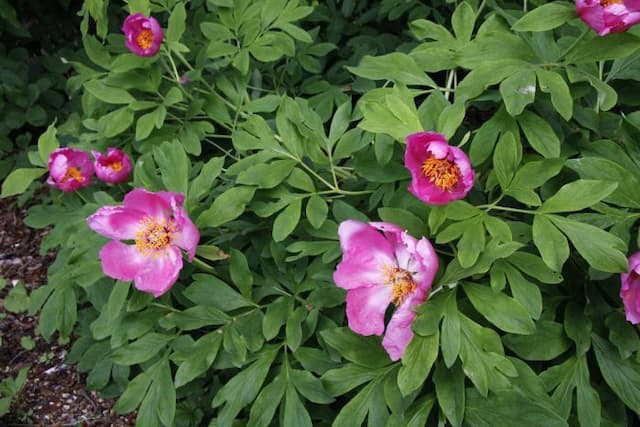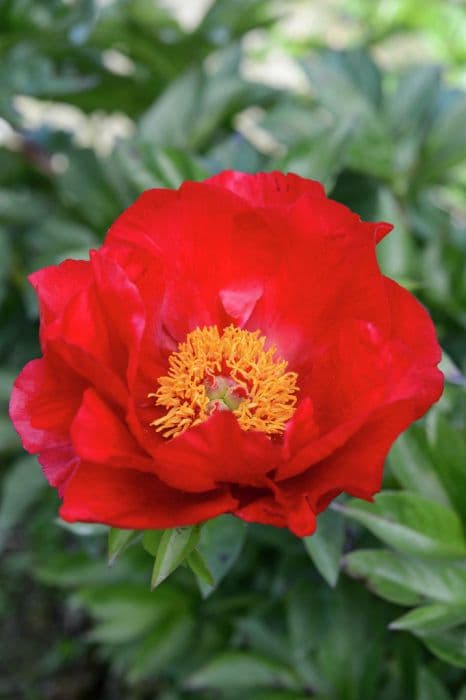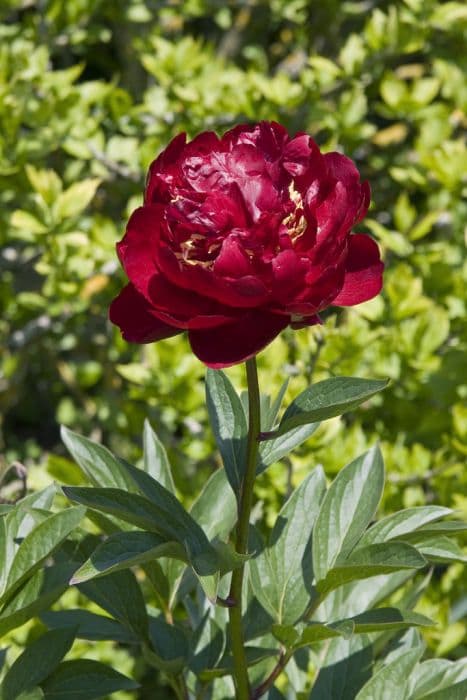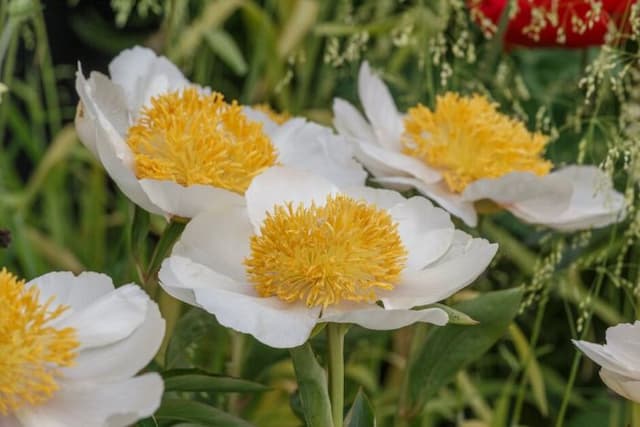Peony Paeonia lactiflora 'Hari-ai-nin'
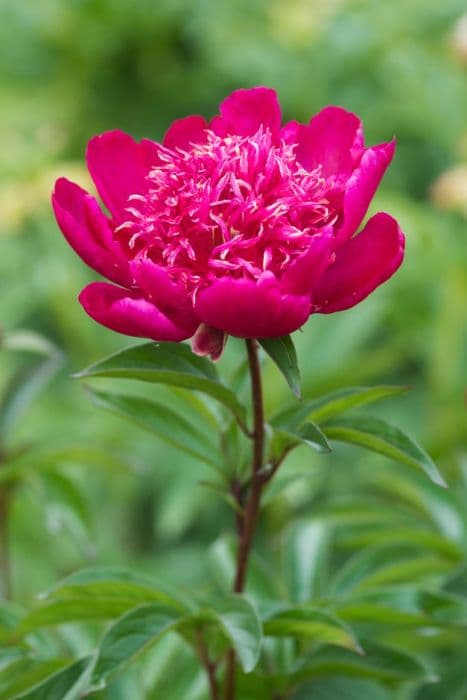
ABOUT
Paeonia lactiflora 'Hari-ai-nin', commonly known as Chinese Peony, is a stunning perennial plant that boasts large, showy blooms. The flowers are characterized by voluptuous, layered petals that may present a silky sheen and are usually rich in color. The hues can range from delicate pinks to deep, romantic reds, exuding a sense of elegance and sophistication. The center of each flower is often filled with a cluster of contrasting stamen, adding depth and texture to the overall appearance. The foliage of the Chinese Peony is equally as lush, with glossy green leaves that provide an attractive backdrop to the flowers. The leaves may exhibit a broad, lance-shaped or oval outline, contributing to the plant's dense, bushy habit. The stems are sturdy and upright, ensuring that the heavy flowers are well-supported throughout their blooming period. As a herbaceous peony, 'Hari-ai-nin' dies back to the ground in winter and re-emerges in the spring with fresh, vibrant growth, ready to capture the attention of any passerby with its opulent blossoms. The blossoms not only captivate with their visual splendor but also may emit a sweet fragrance that drifts through the air, enhancing the sensory appeal of the plant. Overall, Chinese Peony 'Hari-ai-nin' is a breathtaking plant prized for its floriferous display and ability to add a touch of romance to any garden setting.
About this plant
 Names
NamesSynonyms
Chinese Peony, White Peony, Common Garden Peony.
Common names
Paeonia lactiflora 'Hari-ai-nin'.
 Toxicity
ToxicityTo humans
Peony, the most common name for Paeonia lactiflora 'Hari-ai-nin', is not considered highly toxic to humans. However, it can cause mild gastrointestinal upset, including nausea, vomiting, and diarrhea when ingested in large quantities. Individuals with sensitive skin may also develop a rash if they handle the plant's parts excessively.
To pets
Peony can be toxic to pets, including cats and dogs. Ingesting parts of this plant might result in vomiting, diarrhea, and in more severe cases, lethargy. If your pet consumes peony, it is recommended to consult a veterinarian. Symptoms would likely be the result of mild gastrointestinal upset.
 Characteristics
CharacteristicsLife cycle
Perennials
Foliage type
Deciduous
Color of leaves
Green
Flower color
Pink
Height
2 feet 4 inches (70 cm)
Spread
2 feet (60 cm)
Plant type
Herb
Hardiness zones
3
Native area
Asia
Benefits
 General Benefits
General Benefits- Ornamental Value: Paeonia lactiflora 'Hari-ai-nin', commonly known as Chinese peony, adds aesthetic appeal to gardens with its large, showy flowers.
- Garden Design: Chinese peony provides structure and spring color to mixed borders and perennial garden beds.
- Cut Flowers: The blooms make excellent cut flowers, offering fragrance and long vase life for indoor arrangements.
- Attracts Pollinators: The flowers attract bees and butterflies, promoting pollination in the garden.
- Mixed Planting Compatibility: This peony species pairs well with other plants, helping to create diverse and attractive plantings.
- Seasonal Interest: It offers a burst of color in late spring to early summer when the plant flowers abundantly.
- Drought Tolerance: Once established, Chinese peonies can be relatively drought tolerant, requiring minimal watering during dry spells.
- Low Maintenance: Requiring minimal care once established, they are ideal for gardeners looking for low-maintenance plants.
 Medical Properties
Medical Properties- Anti-inflammatory: Some compounds in Paeonia lactiflora may possess properties that help reduce inflammation.
- Analgesic: There is some evidence to suggest that extracts of this plant may have pain-relieving effects.
- Immunomodulatory: The plant may have effects on the immune system, potentially helping to modulate immune responses.
- Antioxidant: Paeonia lactiflora could contain antioxidants that help protect cells from oxidative damage.
- Antispasmodic: It might have properties that can help reduce muscle spasms.
- Cardiovascular health: Some research indicates that the plant may have beneficial effects on heart health.
- Neuroprotective: There is a possibility that this peony variety has properties to protect nerve cells.
 Air-purifying Qualities
Air-purifying QualitiesThis plant is not specifically known for air purifying qualities.
 Other Uses
Other Uses- Paeonia lactiflora is often used in perfumery to provide a delicate, floral fragrance profile to various personal scents and luxury perfumes.
- The plant's sturdy stems can be used in lightweight crafts such as making homemade paper or pressed flower decorations for artisanal greeting cards.
- When dried, Paeonia lactiflora petals can serve as a natural dye for textiles, imparting subtle hues of pink and beige depending on the mordant used.
- The petals of Paeonia lactiflora are edible and can be used as a colorful garnish on salads, desserts, or to elegantly embellish cocktails.
- Its large and showy blooms make Paeonia lactiflora a popular choice for ornamental floral arrangements and wedding bouquets.
- In photography, the plant’s flowers are often used as subjects or backdrops due to their lush and vibrant appearance, enhancing the aesthetic of the image.
- Gardeners can plant Paeonia lactiflora as part of a strategy for companion planting, as it has been known to help deter certain pests from more vulnerable crops.
- The fallen petals of Paeonia lactiflora can be collected to make a fragrant, biodegradable confetti for eco-friendly celebrations and ceremonies.
- Wax figures and scented candles sometimes make use of extracts from Paeonia lactiflora to achieve a subtle, floral scent that is soothing and not overwhelming.
- Paeonia lactiflora can serve an educational purpose in botanical studies and horticulture classes; its growth cycle and morphology offer insights into the life of perennial plants.
Interesting Facts
 Feng Shui
Feng ShuiThe Peony is often used in Feng Shui to promote love and romance, and is sometimes referred to as the 'flower of riches and honor'. It is recommended to place peonies in the southwest corner of a garden or home to enhance relationship luck.
 Zodiac Sign Compitability
Zodiac Sign CompitabilityThe Peony is not used in astrology practice.
 Plant Symbolism
Plant Symbolism- Prosperity: The common name for Paeonia lactiflora 'Hari-ai-nin' is Peony. Peonies are often associated with wealth and honor, symbolizing a wish for prosperity and a successful future.
- Romance: Peonies are also symbols of love and affection. They are frequently used in wedding bouquets and decorations to represent a happy marriage.
- Beauty: With their full, rounded blooms, peonies are emblematic of beauty in all forms, celebrating physical and inner beauty.
- Good Luck: Known as a talisman of good luck, it is believed that peonies bring good fortune to the receiver, making them popular in celebratory occasions.
- Compassion: The lush and soft appearance of the peony bloom is thought to resemble compassion and therefore symbolizes the human capacity for empathy and caring.
 Water
WaterThe common name for Paeonia lactiflora 'Hari-ai-nin' is Peony. Peonies should be watered deeply once a week, providing about 1 inch of water which corresponds to roughly 0.6 gallons per square yard of soil. The soil should be allowed to dry out between waterings to avoid overwatering. During the growing season, especially if the weather is dry and hot, you may need to increase watering frequency. However, it's important to reduce watering after the blooming period as peonies enter dormancy.
 Light
LightPeonies, including Paeonia lactiflora 'Hari-ai-nin', thrive best in full sun to partial shade. They should be planted in a location where they receive at least six hours of direct sunlight daily. Avoiding overly shaded areas will help ensure abundant blooms. Morning sun is particularly beneficial because it dries dew from the leaves, reducing the risk of fungal diseases.
 Temperature
TemperaturePeonies like Paeonia lactiflora 'Hari-ai-nin' prefer temperate climates with winters that provide a period of chilling. They can tolerate winter temperatures as low as -20°F and up to 90°F during the growing season. The ideal growing temperature range for peonies is between 65°F and 75°F.
 Pruning
PruningPruning peonies, like Paeonia lactiflora 'Hari-ai-nin', is essential for maintaining healthy plants and encouraging blooms. Remove spent flowers after blooming to prevent seed formation. In late fall, after the first frost, cut the foliage down to the ground to help prevent disease. Every few years, divide overcrowded clumps to rejuvenate the plant and encourage more vigorous growth.
 Cleaning
CleaningAs needed
 Soil
SoilChinese Peony thrives in well-drained, fertile soil with a pH of 6.5 to 7.5. A good soil mix would contain two parts loam, one part peat moss or well-rotted compost, and one part perlite or coarse sand to ensure ample drainage and aeration.
 Repotting
RepottingChinese Peonies typically do not need frequent repotting and can remain in the same location for many years without issue. However, if necessary due to growth, they should be repotted in the fall after the blooming season.
 Humidity & Misting
Humidity & MistingChinese Peonies prefer average humidity levels but are quite adaptable. They can thrive in the typical range of outdoor humidity levels, as long as they are planted in a well-draining soil.
 Suitable locations
Suitable locationsIndoor
Chinese Peonies are not ideal for indoors; prefer garden planting.
Outdoor
Plant in fertile, well-drained soil; full sun.
Hardiness zone
3-8 USDA
 Life cycle
Life cyclePaeonia lactiflora 'Hari-ai-nin', commonly known as the Chinese peony, begins its life cycle with seed germination in early spring, assuming the seeds have experienced a chilling period to break dormancy. The germinated seedlings grow into young plants that develop a root system and foliage but may not flower for several years. Once mature, the Chinese peony enters a perennial growth phase, emerging annually from a tuberous root with the arrival of warmer weather. During the spring to early summer, it produces large, fragrant flowers that can be various shades of pink, red, or white, depending on the cultivar. After blooming, the plant enters a period of seed development, if pollination has occurred, followed by foliage dieback in the fall as it goes dormant for the winter. Each year, the plant may become larger and more floriferous as it draws energy from its expanding root system.
 Propogation
PropogationPropogation time
Early spring
The Paeonia lactiflora 'Hari-ai-nin', commonly known as the Chinese peony, is typically propagated through division, which is the most popular method for this perennial plant. The best time for dividing peonies is in the fall, when the plants are dormant, usually around late September to October. To propagate by division, carefully dig up the peony plant, ensuring to get as much of the root system as possible. Gently shake off loose soil and rinse the roots if necessary to see the eyes, which are the growth nodes. With a sharp knife, cut the clump into sections, making sure each division has at least 3-5 eyes. Replant the divisions at the same depth they were previously growing, approximately 1.5 to 2 inches (3.8 to 5 centimeters) below the soil surface, allowing enough space for the roots to spread. Water the divisions thoroughly to settle the soil and to help with root establishment.
